2013 Peugeot 508 bonnet
[x] Cancel search: bonnetPage 5 of 340
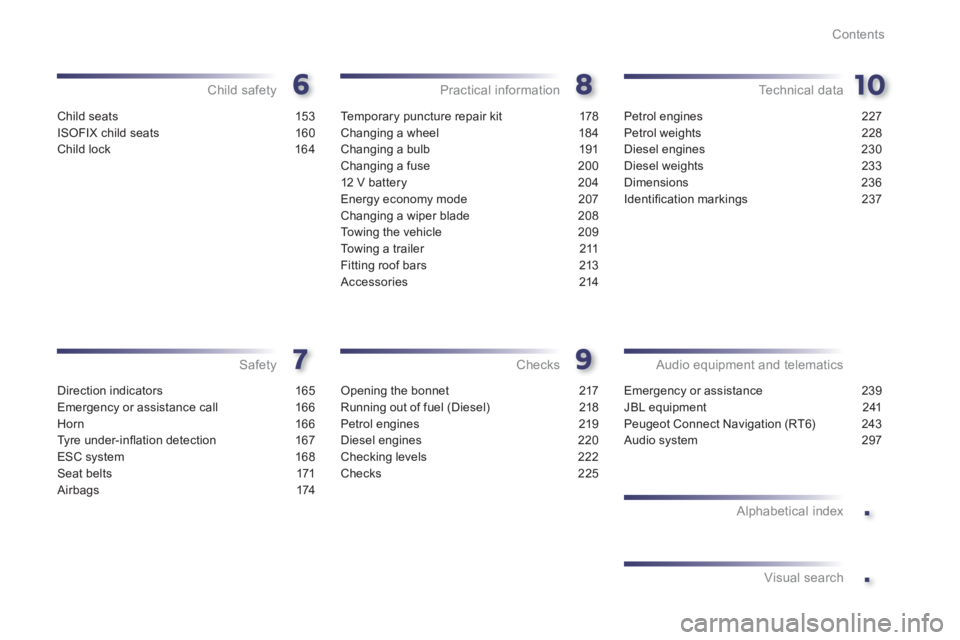
.
.
Contents
Child seats 153
ISOFIX child seats 160
Child lock 164
Child safety
Direction indicators 165
Emergency or assistance call 166
Horn 166
Tyre under-infl ation detection 167
ESC system 168
Seat belts 171
Airbags 174
Safety
Te m p o r a ry puncture repair kit 178
Changing a wheel 184
Changing a bulb 191
Changing a fuse 200
12 V battery 204
Energy economy mode 207
Changing a wiper blade 208
To w i ng the vehicle 209
To w i ng a trailer 211
Fitting roof bars 213
Accessories 214
Practical information
Opening the bonnet 217
Running out of fuel (Diesel) 218
Petrol engines 219
Diesel engines 220
Checking levels 222
Checks 225
Checks
Petrol engines 227
Petrol weights 228
Diesel engines 230
Diesel weights 233
Dimensions 236
Identifi cation markings 237
Technical data
Emergency or assistance 239
JBL equipment 241
Peugeot Connect Navigation (RT6) 243
Audio system 297
Audio equipment and telematics
Alphabetical index
Visual search
Page 12 of 340
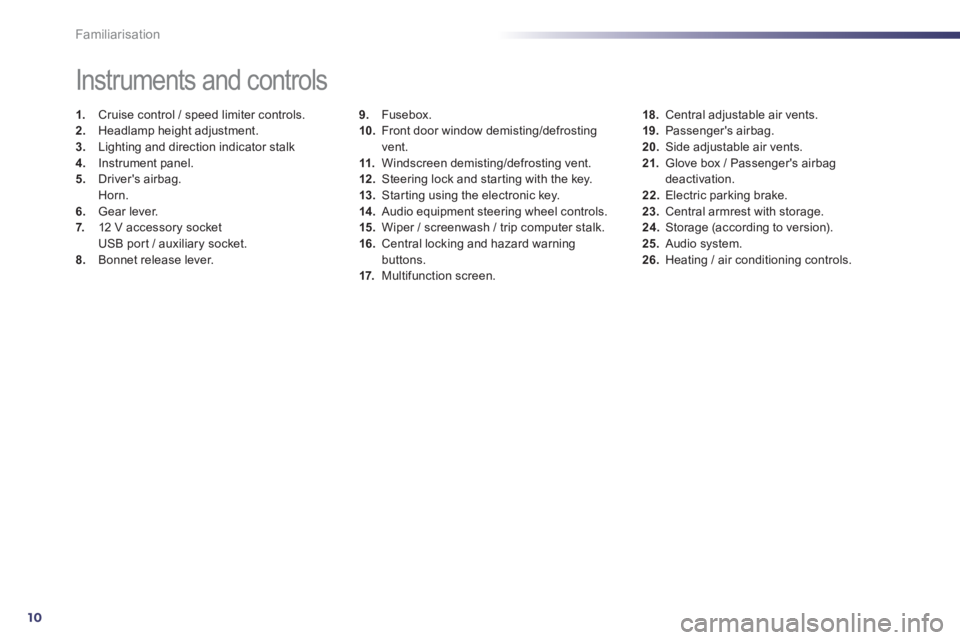
10
Familiarisation
9.Fusebox.
10. Front door window demisting/defrostingvent.
11.Windscreen demisting/defrosting vent. 12 .Steering lock and star ting with the key.
13. Starting using the electronic key. 14 .
Audio equipment steering wheel controls.
15. Wiper / screenwash / trip computer stalk.
16.Central locking and hazard warningbuttons.
17. Multifunction screen.
Instruments and controls
1.
Cruise control / speed limiter controls. 2.
Headlamp height adjustment. 3.
Lighting and direction indicator stalk
4.
Instrument panel. 5.
Driver's airbag.Horn.
6.Gear lever.
7. 12 V accessory socket
USB por t / auxiliary socket. 8.Bonnet release lever.
18.Central adjustable air vents.19. Passenger's airbag.20.
Side adjustable air vents.
21.Glove box / Passenger's airbag deactivation. 22.
Electric parking brake. 23.
Central armrest with storage. 24.
Storage (according to version).25.Audio system. 26.Heating / air conditioning controls.
Page 20 of 340
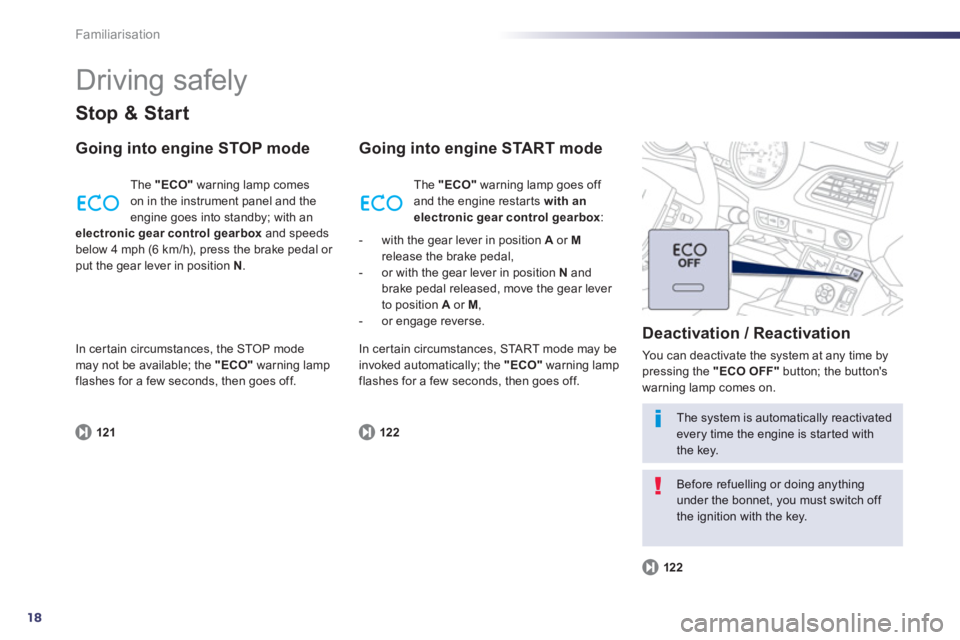
18
Familiarisation
Driving safely
Stop & Start
Going into engine STOP mode
121
The "ECO"warning lamp comes
on in the instrument panel and the
engine goes into standby; with anelectronic gear control gearbox and speeds
below 4 mph (6 km/h), press the brake pedal or put the gear lever in position N.
Going into engine START mode
Deactivation
/ Reactivation
You can deactivate the system at any time bypressing the "ECO OFF"
button; the button's
warning lamp comes on.
122
122
The system is automatically reactivated every time the engine is star ted withthe key.
Before refuelling or doing anything under the bonnet, you must switch off the ignition with the key. Th
e "ECO"
warning lamp goes off
and the engine restar ts with anelectronic gear control gearbox:
- with the gear lever in position A
or Mrelease the brake pedal,
- or with the gear lever in position N
andbrake pedal released, move the gear lever
to position Aor M ,
- or engage reverse.
In certain circumstances, the ST
OP modemay not be available; the "ECO"
warning lamp
flashes for a few seconds, then goes off. In certain circumstances,
STA R T m o d e m ay be
invoked automatically; the "ECO"warning lampflashes for a few seconds, then goes off.
Page 55 of 340
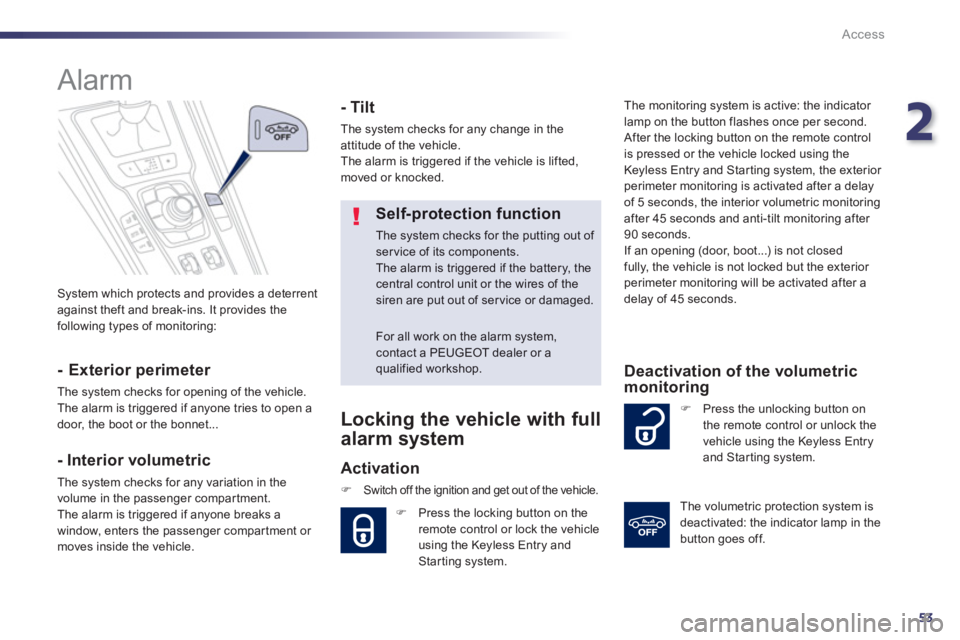
2
53
Access
System which protects and provides a deterrent
against theft and break-ins. It provides the
following types of monitoring:
Alarm
- Exterior perimeter
The system checks for opening of the vehicle.
The alarm is triggered if anyone tries to open a
door, the boot or the bonnet...
- Interior volumetric
The system checks for any variation in the
volume in the passenger compartment.
The alarm is triggered if anyone breaks a
window, enters the passenger compar tment or moves inside the vehicle.
- Tilt
The system checks for any change in the attitude of the vehicle.
The alarm is triggered if the vehicle is lifted,
moved or knocked.
Self-protection function
The system checks for the putting out of ser vice of its components. The alarm is triggered if the battery, thecentral control unit or the wires of thesiren are put out of service or damaged.
For all work on the alarm system, contact a PEUGEOT dealer or aqualified workshop.
Locking the vehicle with full
alarm system
Activation
FSwitch off the ignition and get out of the vehicle.
F
Press the locking button on the
remote control or lock the vehicle
using the Keyless Entry and Starting system. The monitorin
g system is active: the indicator
lamp on the button flashes once per second.
After the locking button on the remote control is pressed or the vehicle locked using the
Ke
yless Entry and Starting system, the exterior
perimeter monitoring is activated after a delay of 5 seconds, the interior volumetric monitoring
after 45 seconds and anti-tilt monitoring after 90 seconds.
If an opening (door, boot...) is not closed fully, the vehicle is not locked but the exterior
perimeter monitoring will be activated after a
delay of 45 seconds.
F Press the unlocking button on
the remote control or unlock the
vehicle using the Keyless Entryand Star ting system.
Deactivation of the volumetric monitoring
The volumetric protection system is
deactivated: the indicator lamp in the
button goes off.
Page 125 of 340
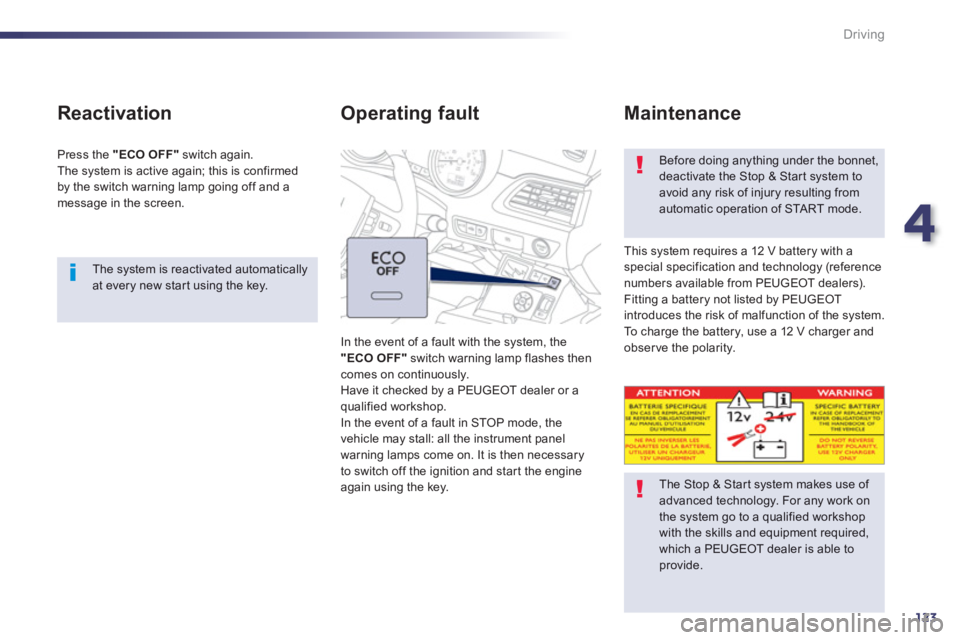
4
123
Driving
The system is reactivated automatically at every new star t using the key.
Reactivation
Press the "ECO OFF"switch again.
The s
ystem is active again; this is confirmed
by the switch warning lamp going off and a message in the screen.
Operating fault
In the event of a fault with the system, the
"ECO OFF"
switch warning lamp flashes thencomes on continuously.
Have it checked by a PEUGEOT dealer or aqualified workshop.
In the event of a fault in STOP mode, the
vehicle ma
y stall: all the instrument panelwarning lamps come on. It is then necessary
to switch off the ignition and star t the engine again using the key.
Before doing anything under the bonnet,deactivate the Stop & Start system toavoid any risk of injury resulting fromautomatic operation of STA R T m o d e .
This system requires a 12 V battery with a
special specification and technology (reference
numbers available from PEUGEOT dealers).
Fitting a battery not listed by PEUGEOT
introduces the risk of malfunction of the system.
To c h a rge the battery, use a 12 V charger andobser ve the polarity.
Maintenance
The Stop & Star t system makes use of advanced technology. For any work onthe system go to a qualified workshopwith the skills and equipment required,which a PEUGEOT dealer is able toprovide.
Page 206 of 340
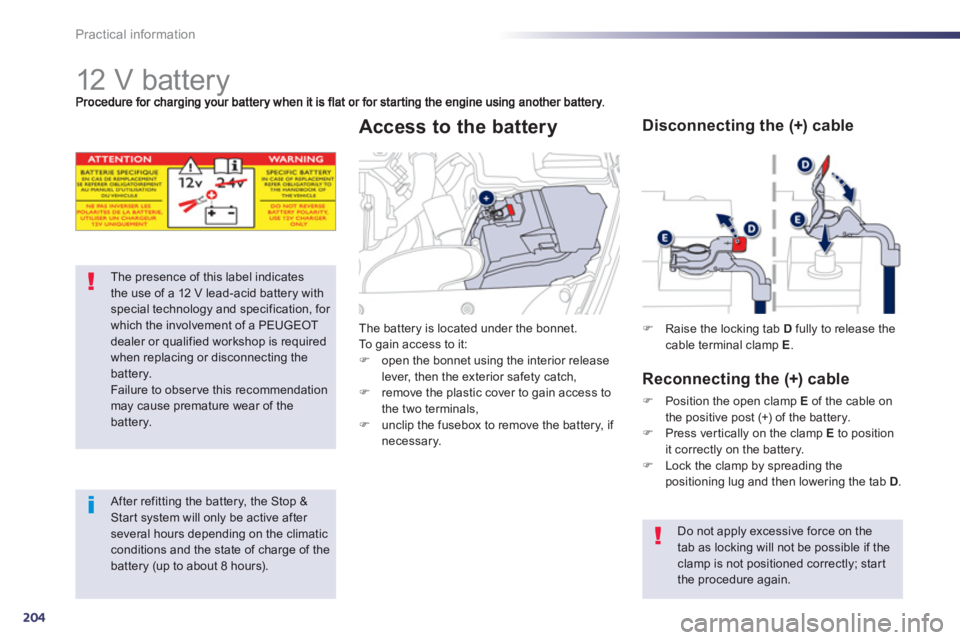
204
Practical information
12 V battery
The presence of this label indicatesthe use of a 12 V lead-acid battery withspecial technology and specification, for which the involvement of a PEUGEOT dealer or qualified workshop is requiredwhen replacing or disconnecting thebattery.
Failure to observe this recommendation may cause premature wear of thebattery.
After refitting the battery, the Stop & Start system will only be active after several hours depending on the climaticconditions and the state of charge of the battery (up to about 8 hours).
The battery is located under the bonnet.
To gain access to it:
F
open the bonnet using the interior releaselever, then the exterior safety catch, F
remove the plastic cover to gain access to
the two terminals,F unclip the fusebox to remove the battery, if necessary.
Access to the battery
F
Raise the locking tab Dfully to release the cable terminal clamp E.
Disconnecting the (+) cable
Reconnectin
g the (+) cable
F
Position the open clamp Eof the cable on
the positive post (+) of the battery.
F Press ver tically on the clamp E
to position
it correctly on the battery. F Lock the clamp by spreading the positioning lug and then lowering the tab D.
Do not apply excessive force on the
tab as locking will not be possible if the clamp is not positioned correctly; star tthe procedure again.
Page 219 of 340
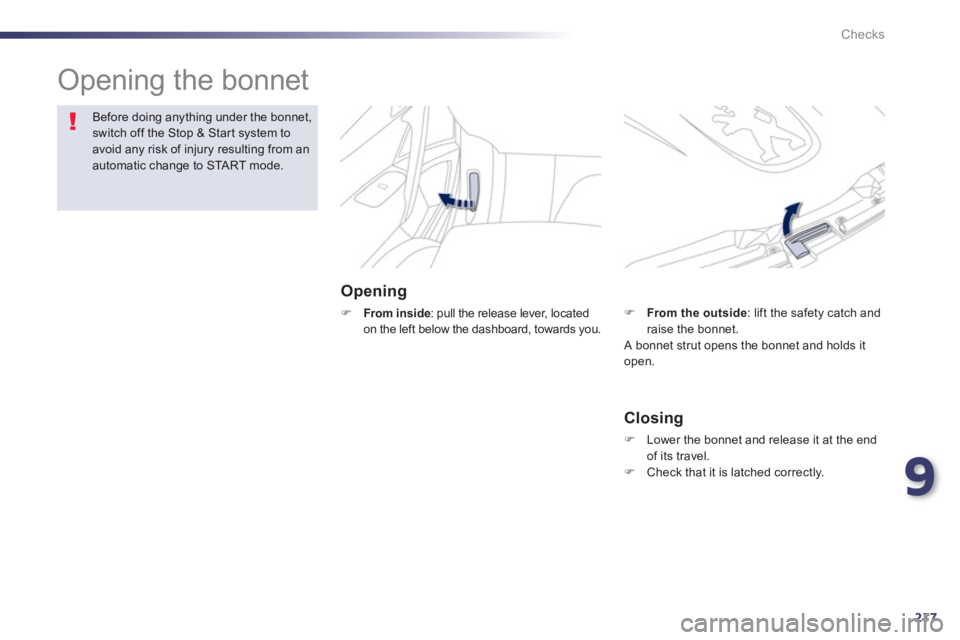
9
217
Checks
Opening the bonnet
Opening
FFrom inside: pull the release lever, located
on the left below the dashboard, towards you.
Before doing anything under the bonnet,switch off the Stop & Start system toavoid any risk of injury resulting from anautomatic change to STA R T m o d e .
Closing
F
Lower the bonnet and release it at the endof its travel. F
Check that it is latched correctly.
FFrom the outside: lift the safety catch and
raise the bonnet.
A bonnet strut opens the bonnet and holds itopen.
Page 220 of 340
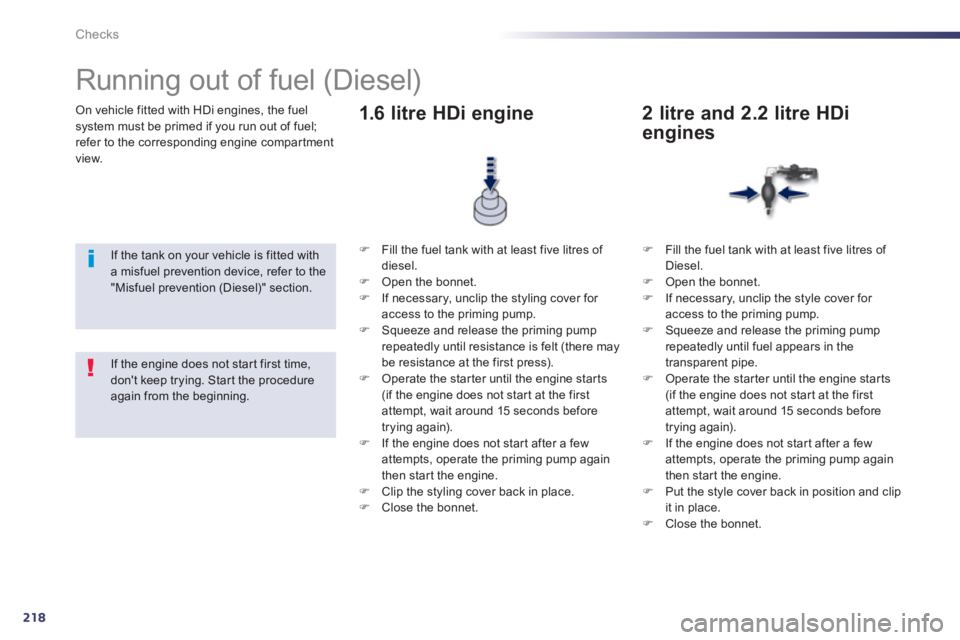
218
Checks
On vehicle fitted with HDi engines, the fuelsystem must be primed if you run out of fuel; refer to the corresponding engine compar tment
view.
Running out of fuel (Diesel)
If the tank on your vehicle is fitted witha misfuel prevention device, refer to the "Misfuel prevention (Diesel)" section.
F
Fill the fuel tank with at least five litres of diesel. F
Open the bonnet.F
If necessary, unclip the styling cover for
access to the priming pump. F Squeeze and release the priming pump
repeatedly until resistance is felt (there may
be resistance at the first press). F Operate the star ter until the engine starts(if the engine does not star t at the first
attempt, wait around 15 seconds before
trying again).
F If the engine does not star t after a few
attempts, operate the priming pump again
then start the engine. F Clip the styling cover back in place. F
Close the bonnet.
1.6 litre HDi engine
F
Fill the fuel tank with at least five litres of
Diesel.F Open the bonnet. F
If necessary, unclip the style cover for access to the priming pump. F
Squeeze and release the priming pump repeatedly until fuel appears in the
transparent pipe. F Operate the star ter until the engine star ts (if the engine does not star t at the first attempt, wait around 15 seconds before
trying again).
F If the engine does not star t after a few attempts, operate the priming pump again
then start the engine. F Put the style cover back in position and clip it in place.F
Close the bonnet.
2 litre and 2.2 litre HDi
engines
If the engine does not star t first time, don't keep trying. Star t the procedureagain from the beginning.